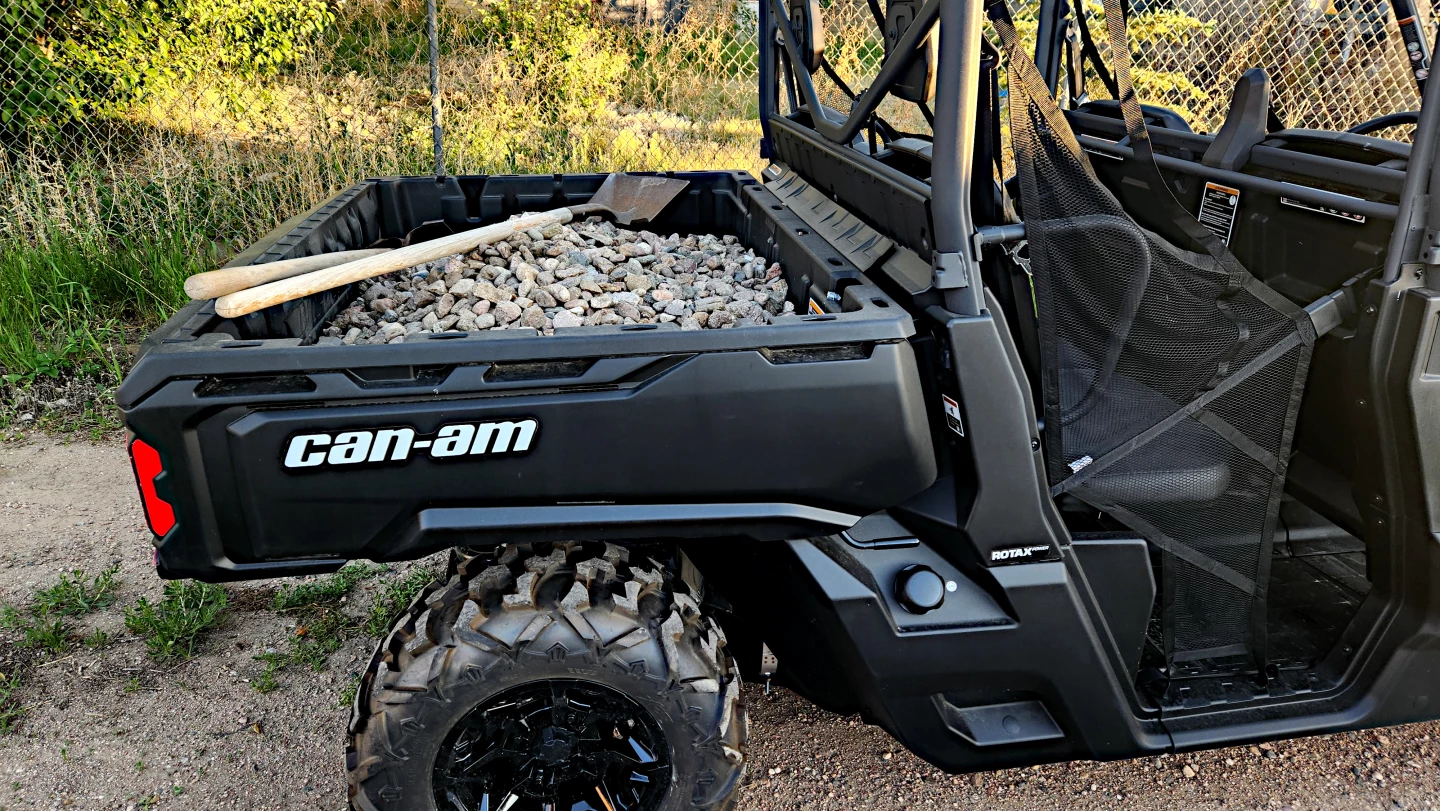A lot of the time, friends and family come to me as “that car guy” to ask about vehicles. Occasionally, though, I step out of that role and do something different – I work with tools. And that is exactly what the Can-Am Defender is.
At a Glance
- Definitely a great tool to have in the shed
- High-torque powertrain
- Useful in-built design and capability
- Modest price tag
The Defender is a tool you can drive around in, sure, but it’s a utility item with almost no frills. Like pickup trucks from the 1970s, the 2024 Can-Am Defender offers no creature comforts, little in the way of electronic technology, and nearly everything about it is form derived from function.
The 2024 Defender comes in three basic designs. A choice between one row of seating (standard model) and two rows of seating (Max) and a six-by-six version of the Max. All three have the same pickup-truck-style dump bed on the back and use the same powertrains. After those considerations, there are 20 models of Can-Am Defender to choose from between the body types. These are mostly trim points with various equipment add-ons or upgrades, including doors, enclosed cabs, winches, and the like. They otherwise boil down to either of two engine and transmission options.
The HD7 models have a Rotax ACE 650cc one-cylinder engine that outputs 52 hp (38 kW) and 42 lb-ft (57 Nm) of torque. This has a pDrive continuously variable transmission (CVT) that powers the rear wheels by default. Four-wheel drive is standard on all Defender models. The HD9 models have a two-cylinder (V-twin-style) 976cc engine that outputs 65 hp (48 kW) and 59 lb-ft (80 Nm) of torque. This has a Pro-Torq CVT in the same rear-wheel setup with 4WD.

I drove the Max (two row) HD9 model. The power output is good, but like most UTVs it is not terribly smooth about doling it out. But it is quieter than others I’ve driven. The transmission requires a little wiggling of the shifter to make sure it goes into the intended gear, however, and often defaults to neutral if the shift stick isn’t put in exactly the right position. A little wiggle, like checking a manual transmission for neutral, will verify if it’s engaged. That quickly becomes a habit.
The selectable 4WD is a toggle switch, as are differential locks, and drive mode selections. These include Eco, Work, and Turf. Eco dampens throttle response and lowers engine noise somewhat as a result. This is about getting around while using less fuel. Work mode maximizes torque output and focuses on pulling heavy and hauling big. It’s kind of the default mode for the Defender. Finally, Turf mode unlocks the rear differential and limits torque output in order to minimize tire spin on grass or landscaping.
Utility vehicles like the 2024 Defender are not about speed of shift or quickness of power delivery (see the Commander for that). They’re about getting a job done. For ranchers, landscapers, large land owners, and the like, there’s nothing more useful than a UTV like this. That’s where the dump bed and large carrying capacity comes into play.
The Defender has a double A-arm front suspension with 10 inches (25 cm) of travel and a torsional trailing arm rear suspension with its own 10 in of travel. Twin-tube gas shocks, 14-inch wheels with 27-inch trail tires, and the aforementioned dump bed are all standard. The dump bed, when swung upwards, doubles as a hood to cover the engine and transmission. Hydraulic piston calipers provide braking at all four wheels, with twin-piston in front and singles in the back.
That truck bed on the back of the Defender provides up to 1,000 lb (454 kg) of cargo capacity with a 250-lb (113-kg) tailgate rating. The Defender can haul a total payload of 1,500 lb (680 kg), including passengers. Its towing (hitch is included as standard) is rated at 2,500 lb (1,134 kg) on 4x4 models or 3,000 lb (1,361 kg) on 6x6 models. Oddly, the cargo capacity is limited to 600 lb (272 kg) in California. Because California always has to be different and requires cancer warnings on everything. You do you, Golden State.
Knowing all of those numbers is one thing. Putting them into the real world is another. For a few weeks, I put the 2024 Can-Am Defender to work around my and my neighbor’s houses. We hauled turf, dirt, rocks, building supplies for a new chicken coop (which I’ve dubbed Coop de Ville), and other stuff. As a roll cage on wheels with a dump bed and no doors, the Can-Am Defender was one of the most useful vehicles I’ve ever driven.

And no, before the “electrify all the things” crowd starts crowing, you can't currently make an EV out of something like the Defender and have it still be so utilitarian. Batteries are still heavy. Adding enough of them to make the Defender capable of doing what it can now with its tiny gas engines would make it too heavy. Suddenly it will leave divots in the turf, can’t be trailered by anything that isn’t a huge pickup truck, and won’t have the same hauling or towing capacity because of its bulk. It’s the same problem that makes electric snowmobiles a limited venue item. It’s physics.
As it is, the 2024 Defender has a starting price of US$12,899 in the smaller models and $15,199 for the Max models.
Product Page: 2024 Can-Am Defender

















